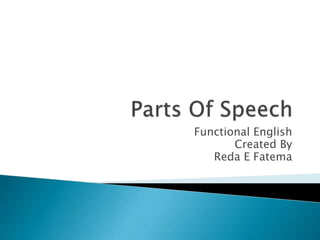
Nouns and Pronouns
- 1. Functional English Created By Reda E Fatema
- 2. Short description of Parts of speech. What they are ???? How they came into existence??? Is the research new or old???? Their major role???
- 3. Words Sentences Grammar Using Lexical items (Parts Of Speech) Combine them according to set of rules Lexicon or vocabulary bank in minds of human beings We use grammar in order to make our sentences Correct
- 4. Dionysius Thrax First to present Comprehensive Grammar Of Greek. He firstly gave the concept Of parts of speech.
- 5. So, parts of speech are basically the categorizing of words into groups according to their usage. There are total eight parts of speech.
- 6. Nouns : A noun is a word that is used to identify any class of the people, places or things or to name a particular one of these. A noun is the name of the person , place ,thing or an idea.
- 7. Hania is a cute girl. Emma passed the test. Taj-Mahal is a wonder of the world. Marie Antoinette was the last queen of France.
- 8. Marie Antoinette was the last Queen of France. When Marie Antoinette was born she had no name but then she was baptized as Marie Antonia Josephina Johanna. She was given this name. Actually giving name to anything is noun whether it is a person, place or a thing. Marie Antonia Josephina Johanna
- 9. Abstract Nouns Collective Nouns Compound Nouns Concrete Nouns Countable Nouns Uncountable Nouns Verbal Nouns Proper Nouns Common Nouns
- 10. An abstract noun names an idea, a quality, a value or a characteristic. You can’t hear, see , smell, taste or touch abstract nouns.
- 12. Software
- 13. Nouns that stand for a collection of persons, animals or things considered as one complete whole are called collective nouns. Group of people Group of animals Group of things Family Team
- 14. Coins Pencils
- 15. Compound nouns are words for people, animals, places, things, or ideas, made up of two or more words. They are of three types: Separated Hyphenated combined
- 16. A concrete noun is a person, place or thing that physically exists and can be seen and touched. These are totally opposite to abstract nouns.
- 17. Countable nouns are easy to recognize. They are things that we can count.
- 18. Uncountable nouns are substances, concepts etc that we cannot divide into separate elements. We cannot "count" them. For example, we cannot count "milk". We can count "bottles of milk" or "litres of milk", but we cannot count "milk" itself. music, art, love, happiness advice, information, news furniture, luggage rice, sugar, butter, water electricity, gas, power money, currency
- 20. A verbal noun is a noun derived from a verb. It exhibits all of the properties of ordinary nouns and none of the properties of verbs.
- 21. Your name is a proper noun. A proper noun is the special word that we use for a person, place or organization, like John, Marie, London, France or Sony. A name is a noun, but a very special noun - a proper noun. Proper nouns have special rules.
- 22. Common noun is the name given in common to every person or thing of the same class or kind.
- 23. A pronoun (I, me, he, she, herself, you, it, that, they, each, few, many, who, whoever, whose, someone, everybody, etc.) is a word that takes the place of a noun.
- 24. Personal Pronouns Demonstrative Pronouns Interrogative Pronouns Possessive Pronouns Relative Pronouns Reflexive Pronouns Intensive Pronouns Reciprocal Pronouns Indefinite Pronouns
- 25. Personal pronouns represent people or things. The personal pronouns are: I, you, he, she, it, we, they, me, him, her, us, them.
- 26. "Demonstrative" means "showing, making something clear." Demonstrative pronouns point to things. The demonstrative pronouns are: this, that, these, those. Use "this" and "these" to talk about things that are near in space or in time. Use "that" and "those" to talk about things that are farther away in space or time.
- 28. "Interrogative" means "used in questions." Interrogative pronouns are used to ask questions. The interrogative pronouns are: who, whom, which, what, whoever, whatever, etc. Use "who" and "whom" to talk about people. Use "which" and "what" to talk about animals and things.
- 29. Example sentences: Who is your father? Whom did you speak to? Which bag did you buy? What are my choices?
- 30. "Possessive" means "showing ownership." Possessive pronouns indicate that something belongs to somebody/something. The possessive pronouns are: my, your, his, her, its, our, their, mine, yours, his, hers, ours, theirs.
- 31. "Relative" means "connected with something." Relative pronouns are pronouns that link different parts of a sentence. The relative pronouns are: who, whom, which, that, whoever, etc.
- 32. "Reflexive" means "going back to itself." Reflexive pronouns show that the action affects the person who performs the action. Reflexive pronouns end in "-self" (singular) or "-selves" (plural). The reflexive pronouns are: myself, yourself, himself, herself, itself, ourselves, themselves.
- 33. "Intensive" means "giving force or emphasis." An intensive pronoun is a pronoun used for emphasis. In other words, intensive pronouns emphasize the subject of the sentence. They are written exactly the same way as the reflexive pronouns, but their function is different.
- 35. Reciprocal means that two people or groups do the same thing to each other. They treat each other in the same way. For example, Joe loves Kate, and Kate loves Joe. So we can say, "Kate and Joe love each other." Another example: Mike helps Lucy, and Lucy helps Mike. So we can say, "Mike and Lucy help each other."
- 37. Akbar loves Jodha Jodha loves Akbar Akbar and Jodha love one another.
- 38. "Indefinite" means "not exact, not limited." Indefinite pronouns are pronouns that do not refer to any specific person or thing.
